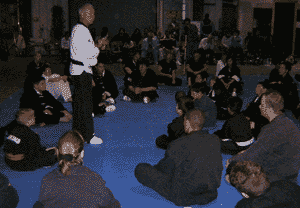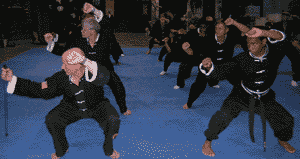

Kung Fu
Tai Chi Chuan
Chi Kung
Weapon Class
(281) 682-3387
BILL "SUPER FOOT" WALLACE SEMINAR Report
On Friday, December 3, 2004, approximately 65 students (from WMA and
other schools) attended the Bill "Superfoot" Wallace Seminar
that covered stretching, kicking, and paired drills for sparring. For
those of you who do not know who Bill Wallace is, he is an "American
Karate Champion, instructor, author, actor, and referee. He was rated
top fighter in the country three times by Black Belt Magazine. Wallace
conducted seminars in Europe, South America, England, and throughout the
U.S. He once taught at the Elvis Presley-owned studio, the Tennessee Karate
Institute where Presley trained with Wallace briefly. Wallace co-starred
in the Chuck Norris film, A Force of One. He is a Member of Who's Who
in the Martial Arts. A Tae Kwon Do/ Shorin-Ryu stylist, he is noted for
his fast left roundhouse kick and left hook kick. In the pro ring he is
remembered for his quick left leg, which gave him the name "Superfoot."
Wallace's ring history is 21-0, 11 KO's. He is the only full contact world
champion to retire undefeated."
The seminar, which took place from 7:00 to 9:30 pm, was intense yet entertaining.
Many attendees noted that Mr. Wallace was focused and informative, yet
lacked no sense of humor when it came to sharing experiences and illustrating
points. Beginning with stretching exercises, there was no lack of wincing
as students were continuously stretched a little more and then a little
more. Following stretching Mr. Wallace covered kicking drills and how
to use them to surprise an opponent. In fact, a large focus of the seminar
was "setting up an opponent" so that the most benefit from the
techniques could be had. To conclude the seminar, Mr. Wallace discussed
four basic boxing punches/techniques, and finished up with a round of
shadow boxing. After the seminar, everyone was given the opportunity to
have Wallace sign posters and take pictures.
Everyone thoroughly enjoyed the seminar and felt that they had learned
something new or had picked up a new perspective on a technique they already
knew (or both). The 16 students of Sweetwater Christian School, a private
school that has expanded their P.E. program to include martial arts instruction
from Wang's Martial Arts, were especially thrilled. These students (which
were compiled from the top students in each grade) were offered the seminar
for their hard work and focus and as an incentive to "keep up the
good work" and continue bettering their martial arts. Each student
had a poster autographed to take home and was given the opportunity to
take photos with "Superfoot." With smiles and sore muscles,
everyone left with something new and valuable.






Date: March 05, 2005 ( Saturday)
Time : 10:00 am - 4:00 pm
Place : Sweetwater Christian School
350 Century Plaza Dr.
Houston, TX. 77073
For information : call (281) 548-1638, (281) 682-3387
Ages 9-14 01/20/05 (Thursday) 6:00 - 8:30 pm
Ages 5- 8 01/22/05 (Saturday) 1:00 - 3:30 pm
Ages 15-80 01/22/05 (Saturday) 3:00 - 6:00 pm
Colorful Teas
By: Lisa James
September 2004 "Energy Times"
While America has traditionally been a coffee-drinking nation, our java infatuation is now yielding to tea's charms. Tea sales have increased fivefold over in the past decade and currently stand at $5.5 billion a year. Roughly 95% of those sales come from black tea, although news about green tea's health benefits has caused sales to soar.
Both black and green tea come from the same plant, Camellia sinensis. The difference lies in how they are handled; black teas are fermented before drying, while green teas are heated after picking to prevent fermentation. Oolong tea is partially fermented, falling between black and green, and white tea is processed more quickly than standard green, yielding a more delicate brew. (By the way, 'orange pekoe" isn't a type of tea, but a specific leaf size.)
Health by the Cupful
Seventh-century medical writer Pen ts'ao noted that tea "gladdens and cheers the heart." Caffeine is the stimulant that mainly accounts for tea's heart-gladdening capacity. Many people find tea's invigoration to be gentler than that of coffee, which has more caffeine. Tea also contains L-theanine, a substance that encourages the brain to produce the same types of relaxing alpha waves generated during meditation.
Tea's real health bonanza lies in its polyphenols, substances known collectively as catechins. These substances are antioxidants, able to defuse the destructive power of cell damaging molecules known as free radicals. The most studied green tea polyphenol is epigallocatechin gallate (EGGG). Black tea's equivalent compounds, the theaflavins, have been found to be equally potent antioxidants (J Nutr 2001; 131:2248-51). It's estimated that tea, black and green, has 10 times the antioxidants found in fruits and vegetables.
Standard tea isn't the only entry in the antioxidant derby. Rooibos (Aspalathus linearis), also called "red tea' or "red bush," is a South African plant that contains potent antioxidants and a healthy dose of vitamin C as well. Caffeine-free rooibos is useful for calming frayed nerves.
Hearty Tea
Accumulated evidence suggests that tea drinkers can take their favorite beverage to heart.
In Japan, where most people imbibe green tea, one study found that increases in tea consumption were linked to reductions in arterial narrowing among men who didn't have diabetes (Ann Epidemiol 2000;10:4018). In addition, a Dutch study of more than 4,800 individuals found a link between tea consumption and reduced heart attack risk (AJCN 2002; 75:880-6). Researchers have also found that tea drinkers are more likely to survive after an attack occurs ( Circulation 2002; 105:2476-81).
To explain why tea protects the heart, scientists theorize that green tea's catechins prevent free radicals from oxidizing low-density lipoprotein (LDL)' oxidized LDL is the kind of cholesterol that can block arteries. But catechins may help the heart in other ways as well. For instance, EGCG appears to inhibit a gene linked to abnormal heart rhythms that can occur after heart attacks (Heart Rhythm Society, 2004).
What's more, it seems that black tea may share green tea's heart-healthy properties. In one study, coronary arteries in 10 healthy men who drank black tea showed a greater ability to provide increased blood flow when the heart indeed it ( Am J Cardiol 2004;93(11):1384-8).
Brewing Cancer Protection
Free radicals are thought to promote cancer by damaging the DNA that allows cells to reproduce; that leads to cell mutations that can trigger malignancies. Tea's antioxidants quench these free radicals.
But that is not tea's only cancer-fighting weapon. In addition to preventing cell damage, these powerful antioxidants have reduced tumor size and inhibited cancer cells. EGCG has shown some ability to disrupt survival signals in certain types of leukemia cells, and both white and green tea have reduced tumor formation in the lab (Blood 3/2/04, early online edition; Carcinogenesis 2003; 24920:263-7).
Tea has also been shown to lower the risk of cancer. Among people with liver problems, green tea extract reduced levels of substances linked to liver cancer (Frontiers in Cancer Prevention Research meeting, 10/03). And in one Chinese study, protection against prostate cancer increased in men who drank the most tea for the longest amount of time. (Int J Cancer 2004:108(1):130-5).
Even after cancer develops, tea may be helpful. Among men with prostate cancer, quaffing green or black tea lowered levels polamines, chemicals associate with malignancy (Experimental Biology 2004) Health practitioners have used L-theanine, the relaxing agent in tea, to reduce anxiety and chemotherapy side effects (Alt Complemen Med Dec 2003, 284-8).
Thinning Down, Building Bone
While it isn't a cure-all, tea comes close: "[A]n impressive amount of evidence has accumulated to link green tea with good health," writes Lester Mitscher, PhD and Victoria Dolby in The Green Tea Book (Aver/ Pengin). "[G]reen tea seems to do it all."
If you want to thin down, drink tea. While scientists had long attributed tea's weight-loss effects to its caffeine content, recent research indicates that the catechin EGCG helps stimulate the production of calorie-burning body heat and interferes with fat absorption. In France, overweight individuals who took green tea extract saw their scale reading and their waist sizes shrinking after 12 weeks (Phytomed 2002; 9:3-8)
Tea also toughens bones. A survey of more than 1,200 women found that tea drinkers had denser, more fracture-resistant hipbones, especially if they added milk to their favorite beverage (AJCN 2000; 71(4): 1003-7).
Rheumatoid arthritis (RA), caused by immune system attacks on joint tissue, may be blunted by tea antioxidants. Lab mice that imbibed green tea extract were less likely to develop an RA-like condition, and mice that already suffered from arthritis developed less severe forms of the disorder. What's more, the researchers who performed this study point out that people who live in countries where tastes run to green tea are less likely to suffer from RA ( PNAS 1999; 96 (8): 4524 -9).
Dozens of health and beauty products include green tea, and for good reason. Green tea compounds help rejuvenate skin cells, and oolong tea has helped some people with stubborn atopic dermatitis, a type of allergic reaction, find relief (Arch Dermatol 2001'137:42-3).
Don't forget the mouth wash: both white and green tea help kill cavity-causing germs, supporting the traditional taking of green tea for oral health after meals in Japan and China.
Extracts: Tea to Go
Nothing beats a tea break, but sometimes your busy schedule doesn't allow it. Or maybe you just don't like tea (gasp!) but want in on tea's health advantages.
No problem. Green tea is readily available in extract form, either as is or blended with other nutrients to create supplements for specific health needs (such as weight loss), as well as functional foods and beverages. Extracts only allow you to get your tea on the go, but they also allow you to get tea's beneficial compounds in a reliable, standardized form.
Refreshment, relaxation, pick-me-up, disease prevention: colorful tea is always in style.